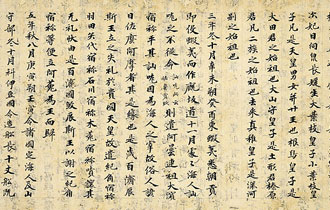Pages |
It is nō which developed in the earlier medieval period, that is most suggestive and the least accessible to the uninitiated. Nō is in many respects more a performance of dance and music than drama. And the suggestive quality is apparent in spite of the fact that again live male actors, not dolls, appear on the stage. Their expressionless or masked faces, the haunting sound of their voices, and their very controlled and deliberate body movements, are almost more doll-like than the ningyō, the dolls/puppets themselves. Nō is not theater into which the real world intrudes upon the stage, as it can in kabuki and bunraku.
Even those kabuki plays that are dramatizations or dances drawn from nō, that is, are reflections of nō, like Dōjōji, bring with them a greater amount of entertainment and spectacle than their nō counterparts. In Dōjōji, there is a faster tempo, a more sensuous movement of the male actor playing the woman who has been spurned by a priest, a larger musical accompaniment, and a brighter and more elaborate costume than we see in the nō. The nō Dōjōji, by the way, is the only piece in all of the nō repertory that has a large prop attached to the stage, a bell; the others use temporary props. Dōjōji, is one of only a few dance pieces in nō that employs intricate footwork.
Kabuki is both accessible and entertaining, spectacular and engrossing. Yet, in spite of the very humanness of its situations and the garnishes of actions from real life, kabuki is hardly a realistic theater. Like many theatrical forms it recreates life by limitation and exaggeration, as Chikamatsu Monzaemon (1653-1724), the so-called Shakespeare of Japan, so skillfully accomplished. This is done in kabuki, according to Kawatake Toshio, an important Japanese critic of Japanese theater, by the accentuation of particular aspects of the productions, especially those of sight and sound. The audio sector of the kabuki performance can be very elaborate-there are instrumentalists with drums, stringed shamisens, and fue (Japanese flute) hidden behind the bamboo curtains above the stage on the right and the left or in some plays, especially those influenced by nō, lined along the back of the stage. There is singing, chanting, metered language, and the sound of the clapper at stage left, which announces the show and highlights the dramatic climaxes.
In its visual effects kabuki is spectacular. The sets are more a visual thriller than simple reproductions of real Japanese homes, palaces, islands, and so forth. The stage revolves to reveal great expanses of space for the audience. The make-up, kumadori, sometimes far-fetched, is always apparent; the costumes are often elaborate and gorgeous for the main actors, who on occasion engage in very quick costume changes, called hayagawari. Movements and gestures, often highly exaggerated, include the aragoto, macho style of male acting; the very deliberate exit, called roppō, on the hanamichi, the bridge leading from the stage to the back of the audience; the mie a facial expression assumed at moments of high emotion, in which the actor makes a grandiose stance, opens his eyes wide, crosses one of them and stops the show so that the audience can take a look at him. All of this is spectacle, entertainment, that causes the audience to forget its mundane, everyday life. Reflective of kabuki practices, bunraku also provides a visual spectacle. The dolls often move in front of and within interesting sets, wear elaborate costumes, and assume exaggerated stances and gestures that duplicate those in kabuki. The emotions are convincingly elicited when, for example, a woman hears that her husband plans to commit suicide with his lover and forsake her, or a man sacrifices the life of his son and tells his wife that he will do so. Some dolls with movable eyes can even assume a mie, which the audience, knowledgeable about the conventions of kabuki, can easily appreciate as a reflection of that theater.
Pages |











